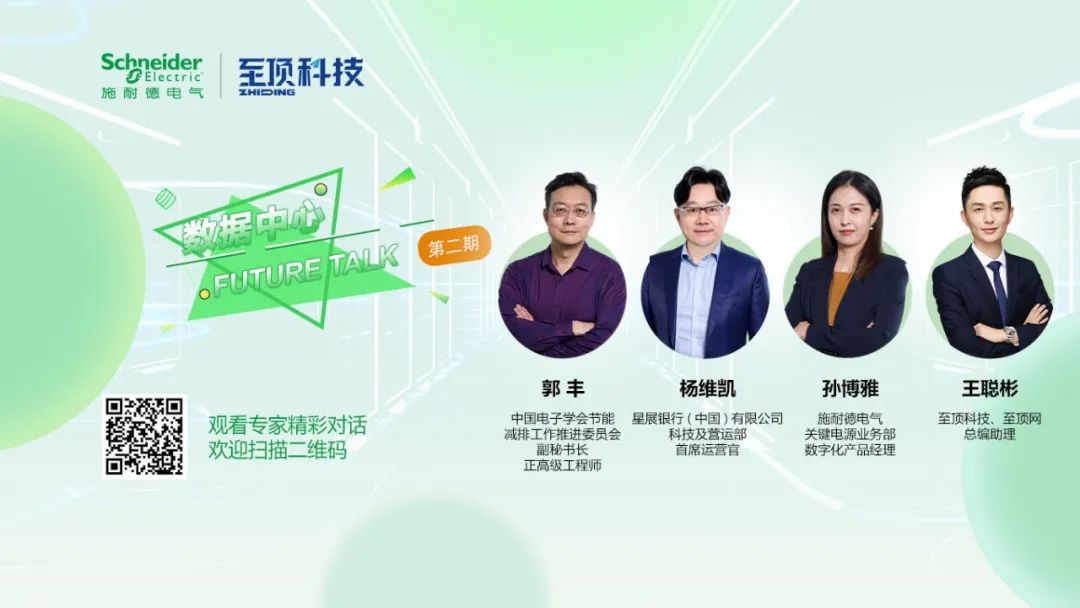Recently, Guo Feng, Deputy Secretary-General of the Energy Conservation and Emission Reduction Working Committee of the China Electronics Society and Senior Engineer, Yang Weikai, Chief Operating Officer of DBS Bank (China) Co., Ltd., and Sun Boya, Digital Product Manager of Schneider Electric’s Critical Power Business Unit, were guests on the data center’s “Future Talk” program, discussing and analyzing the topic of “Efficient Operations Management of Edge Computing Data Centers.”
Editor | Wu Chunqiu
Since the 1960s, data centers have become the most important component of enterprise IT infrastructure. By the 1990s, with the development of cloud computing, enterprises began to experiment with distributed computing to handle computing tasks and achieve instant sharing of computing storage. In recent years, the continuous growth of IoT users and the ongoing development of technologies such as artificial intelligence have made decentralized edge computing a key support for enterprises to thrive in the digital age.
The boundaries of data centers, in the broad sense, are gradually blurring as they expand to include cloud providers, managed facilities, edge devices, and edge computing. Accompanying this is increasing complexity—factors such as performance, reliability, compliance, and security make hybrid computing environments more challenging to manage. Among these, how to address the operational management challenges of edge computing has become a significant challenge faced by enterprises.
Recently, Guo Feng, Deputy Secretary-General of the Energy Conservation and Emission Reduction Working Committee of the China Electronics Society and Senior Engineer, Yang Weikai, Chief Operating Officer of DBS Bank (China) Co., Ltd., and Sun Boya, Digital Product Manager of Schneider Electric’s Critical Power Business Unit, were guests on the data center’s “Future Talk” program, discussing and analyzing the topic of “Efficient Operations Management of Edge Computing Data Centers.”


Cooperative Evolution from Cloud to Edge
The transition from cloud to edge has gradually become a new trend for enterprise deployment. The term “octopus-style” is a vivid metaphor in the industry for the cloud-to-edge model. An octopus has neurons distributed throughout its body, with 40% in its head and the remaining 60% spread across its legs. This structure of one central brain coordinating and N smaller brains executing tasks resembles the architecture of central cloud plus edge.
In this architecture, the cloud and edge each play their roles and interact with each other. Cloud computing, with its powerful data centers, provides scalable computing, storage, and networking capabilities for business applications, suitable for non-real-time, long-cycle business scenarios. Edge computing focuses on real-time, short-cycle, and local decision-making scenarios, such as audio and video live streaming, IoT, and the metaverse, bringing workloads closer to end devices or final users to achieve lower network latency and enhance user experience.
5G and IoT technologies have driven a series of high-demand services for data processing latency, such as visual recognition and autonomous driving. Traditional data centers cannot respond timely to these services. Guo Feng believes that edge data centers can effectively assist in data processing tasks that require low latency.
As a global leader in data center infrastructure construction and digital services, Schneider Electric categorizes edge computing into three types based on the characteristics of the infrastructure environment: the first type is IT environments, which are dedicated spaces for IT or computing devices, such as server rooms, enterprise network distribution rooms, and small data centers, built according to standard specifications with good environmental cleanliness; the second type is commercial office environments, such as offices and logistics centers, which may face issues with temperature, humidity, noise, and dust; the third type is industrial and harsh environments, such as production lines and instrument rooms, where equipment is mostly exposed in factories, facing significant physical threats.
“These are all typical edge computing scenarios that pose operational challenges due to their distributed nature, unfriendly environments, and unattended operations,” Sun Boya further elaborated.
As a representative enterprise of edge computing deployment, DBS Bank is the first foreign bank in China to fully adopt IoT sensors in its self-operated IT rooms. DBS Bank is a leading financial services group in Asia, operating in 19 markets, with its representative office established in Beijing in 1993, and in May 2007, it became one of the first foreign-funded banks registered in China. DBS’s branch network and business have rapidly developed, with 12 branches and 22 sub-branches currently in China.
Adhering to the principle of “data-driven decision-making,” DBS Bank has conducted extensive explorations and practices in digital upgrades. Yang Weikai introduced that in recent years, DBS Bank has continuously explored the use of innovative technologies and digital drives to improve productivity while focusing on reducing energy consumption and protecting the environment in daily operations. In 2023, DBS Bank digitized its data center management by installing sensors in all its IT rooms, benefiting from edge computing in risk management, environmental sustainability, and procurement optimization.

Technological Responses to Edge Computing Operational Challenges
Although most enterprises have recognized the advantages of edge computing, resilience, security, and sustainability remain significant challenges in hybrid environments.
“Edge computing is generally closer to business, and the environment poses significant challenges. Additionally, the increase in operational scale raises stricter professional requirements for operators, and the load variations in edge computing demand higher control capabilities from the infrastructure,” Guo Feng stated.
Specifically regarding operational management, the most common issues focus on increased infrastructure complexity, 100% availability requirements, limited resources, multiple monitoring tools, and distributed sites.
In this regard, DBS Bank faces the most direct operational challenges related to manpower, risk control, and sustainability. Yang Weikai indicated that relying on manual inspections at distributed locations is not only inefficient but also leads to delayed responses when risks occur. Edge computing nodes can facilitate better and more scientific management.
Regarding typical issues such as manpower, professional knowledge, and numerous suppliers, Sun Boya believes that various roles, including end-users, equipment suppliers, and operational service providers, need to utilize digital management tools to form ecological collaboration as the key to solving these problems.
Previously, DBS Bank collaborated with Schneider Electric to deploy 477 IoT sensors across branches and sub-branches at the beginning of 2023, achieving improvements in three areas:
First, reducing risks and increasing productivity. For banks, security and risk management are crucial. With the help of Schneider Electric’s EcoStruxure IT Infrastructure Expert (ITE), DBS Bank effectively avoided a significant amount of on-site inspection work caused by false alarms. In the first three months of using the new system, DBS Bank successfully identified and filtered out over 70% of false alarms.
Second, enhancing sustainability. In the past, to ensure temperature conditions did not exceed alarm thresholds, some on-site users might have overcompensated by setting temperatures far below actual needs, leading to unnecessary low temperatures in server rooms. Thanks to Schneider Electric’s IT Infrastructure Expert (ITE), users can monitor on-site temperatures in real-time and promptly correct any overcompensation to avoid energy waste.
Third, optimizing procurement and costs. Sensors also play a crucial role in extending equipment lifespan. For example, by collecting actual load data from each site’s UPS, DBS Bank can determine the appropriate UPS power based on collected data to meet operational needs without causing overcompensation. This also helps the bank better plan the real estate requirements for its IT server rooms.

Digital Empowerment of Edge Evolution
Digitalization has permeated various industries, and data centers are no exception. Data centers themselves provide the foundation for digital empowerment while also being users of digitalization. Guo Feng believes that digitalization can improve management efficiency, provide collaborative methods for edge data centers, and reduce costs.
Guided by digital upgrades, the adoption of IoT sensors in all IT server rooms has allowed DBS Bank to see tangible efficiency gains and environmental benefits, marking an important step in its digital transformation strategy. DBS Bank will continue to explore and utilize technology in operations, promoting green operations, especially in digital-driven management.
“Combining EcoStruxure EAA (Remote Expert Services) with EcoStruxure ITE (Infrastructure Expert) digital services can provide clients with professional teams, equipment experts, cloud platforms, and more support, enabling efficient operations while reducing service costs,” Sun Boya said. ITE supports device data visualization, timely alerts, and users can access the system anytime and anywhere via apps and web interfaces. Additionally, various access gateways are available, including the Dera and Kit series suitable for centralized access in any scenario, from edge devices to large data centers; the ITE Card 4G gateway can connect to a single device, suitable for edge sites with dispersed devices and no networking conditions. EAA provides round-the-clock online resources and expertise, offering problem diagnosis and solutions through proactive monitoring and foresight asset insights by remote experts.
As one of the new infrastructures, edge computing continues to evolve, providing computational support for emerging businesses and models. Discussing future trends, Guo Feng pointed out that automation, unmanned operations, and intelligence will be important directions for its future development.
Sun Boya stated that only by integrating data from edge devices with digital technologies like AI can we truly unlock the value of data. Schneider Electric is actively laying out plans to incorporate big data, artificial intelligence, and other technologies into its digital tools, continuously enhancing operational efficiency, reducing costs, and improving information security networks, using innovative digital services to provide solid support for clients.




Automotive Track Becomes a Hotspot: Insights from Day One of CES 2024

CES 2024 | Intel Enters Automotive Market, Zeekr Becomes the First Verified Manufacturer
